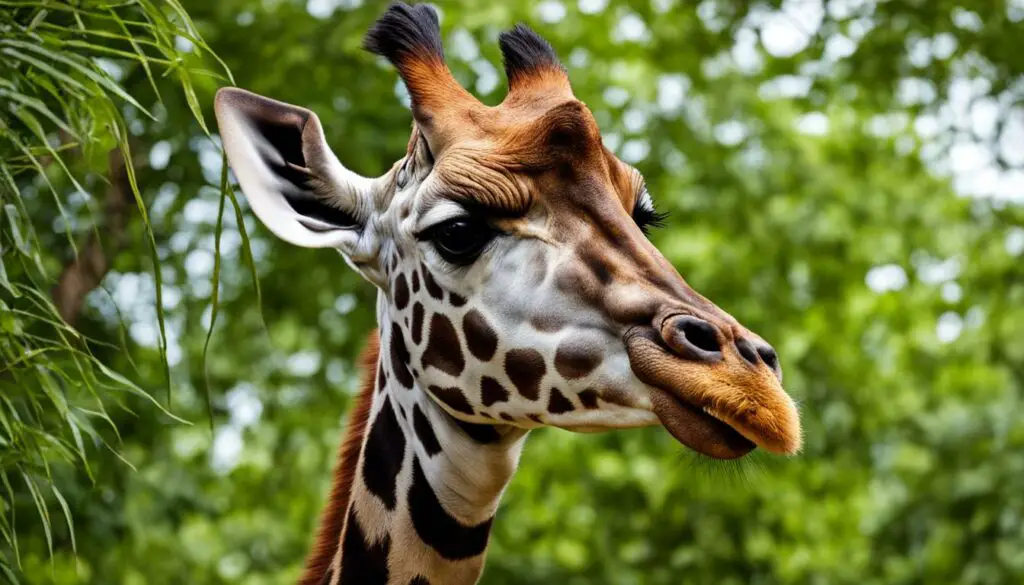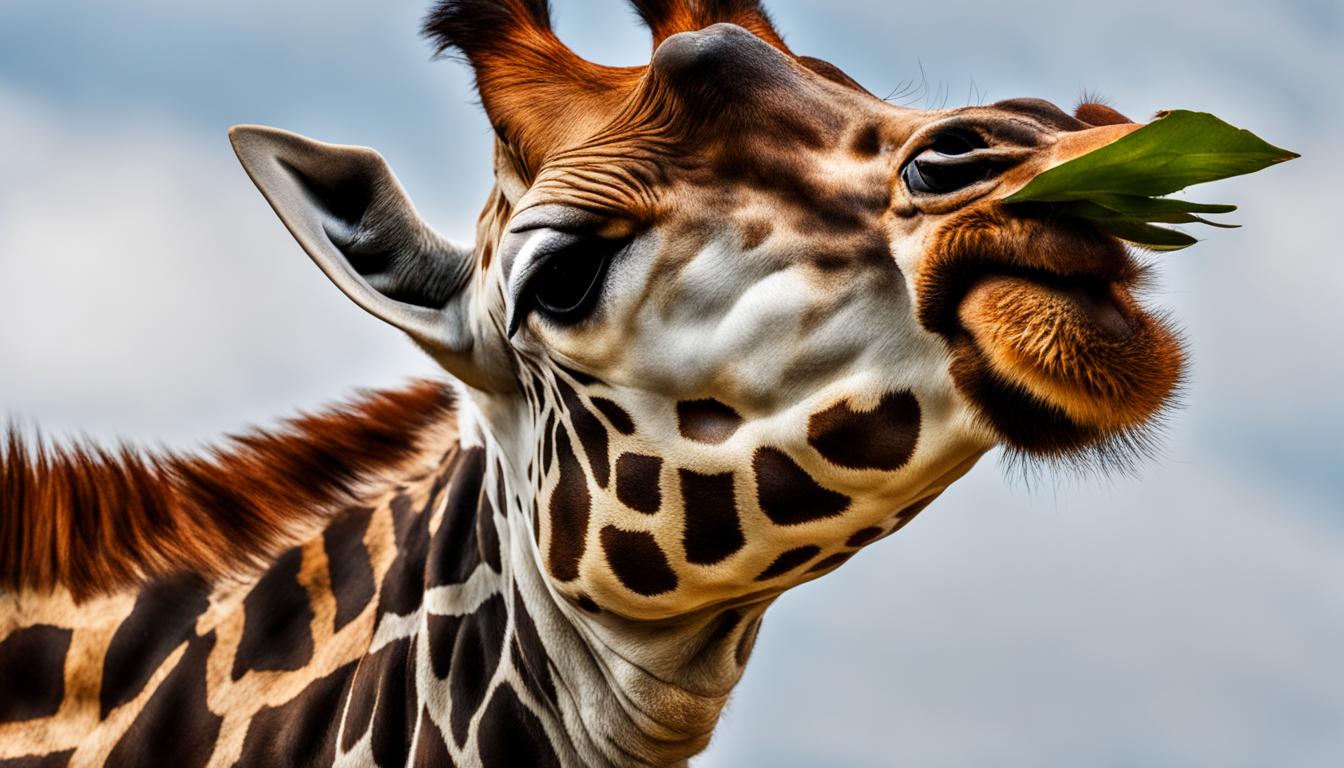Have you ever wondered how long a giraffe’s tongue is and what it’s used for? In this article, we’ll explore the fascinating world of giraffe tongues and their remarkable adaptations for feeding. From their impressive length to their unique anatomy, giraffes have some truly remarkable characteristics. So let’s dive in and discover the wonders of the giraffe’s tongue and how it helps them survive in their natural habitat.
Giraffes are known for their incredibly long tongues. Despite having necks that can stretch up to six feet, a giraffe’s tongue typically measures 18-20 inches in length. This long tongue is essential for their survival as it allows them to reach the highest, tastiest leaves on acacia trees while avoiding the sharp thorns that protect them.
The giraffe’s tongue also has a thick, tough layer that protects it from being cut by thorns, and the saliva has antiseptic properties to aid in quick healing if any injuries occur. Additionally, the dark color of the giraffe’s tongue may help protect it from the sun’s harmful rays during their long hours of feeding.
Stay tuned as we delve deeper into the anatomy and function of the giraffe’s tongue. You’ll be amazed at the adaptations that make this unique feature possible and how it contributes to the survival of this majestic creature. So, let’s embark on this wild journey together and explore the wonders of the giraffe’s tongue!
Giraffe Tongue Anatomy and Function
When it comes to animal tongues, the giraffe’s tongue is truly remarkable. Not only is it long, measuring about 18-20 inches, but it also has unique anatomical features that enhance its function. The giraffe’s tongue is prehensile, which means it can grasp and manipulate objects. This allows giraffes to use their tongues to adeptly remove leaves and shoots from even the thorniest of plants, ensuring they can reach the highest and tastiest leaves.
The surface of the giraffe’s tongue is textured with papillae, which enhances grip and helps secure leaves during feeding. This specialized adaptation allows the giraffe to navigate through thorny plants without injuring its tongue. Additionally, the muscular build of the giraffe’s tongue enables it to stretch, contract, and maneuver with ease, further aiding their feeding process. This flexibility allows giraffes to reach leaves that other herbivores cannot access, giving them a competitive advantage in their habitats.
Furthermore, the giraffe’s tongue plays a crucial role in the swallowing mechanism. After the giraffe chews its food, the tongue guides the chewed food to the back of the throat for efficient digestion. This ensures that the giraffe can process and extract nutrients from its diet effectively. With its unique anatomy and function, the giraffe’s tongue is a powerful tool that enables these magnificent creatures to thrive in their environment.
Table: A Comparison of Tongue Lengths in Various Animals
| Animal | Tongue Length |
|---|---|
| Giraffe | 18-20 inches |
| Chameleon | 1.5-2 times body length |
| Blue Whale | up to 10 feet |
| Giant Anteater | up to 2 feet |
As shown in the table above, the giraffe’s tongue length is truly remarkable compared to other animals. Its long and versatile tongue allows giraffes to reach food sources that may be inaccessible to other herbivores. This unique adaptation, coupled with the giraffe’s feeding behavior and other anatomical features, contributes to their survival and dominance in their habitats.
Understanding the anatomy and function of the giraffe’s tongue provides insights into the incredible adaptations that animals develop to thrive in their environments. The giraffe’s long, textured, and muscular tongue is not only a fascinating feature but also a vital tool for their survival. It enables them to feed on high and often thorny vegetation, extracting nutrients efficiently. The giraffe’s tongue exemplifies the wonders of evolution and the extraordinary diversity of adaptations found in the animal kingdom.
Giraffe Tongue Adaptation for Feeding
The giraffe’s long and versatile tongue is a remarkable adaptation that allows these magnificent creatures to thrive in their natural habitats. With a length of 18-20 inches, the giraffe’s tongue enables it to reach the highest leaves on acacia trees while avoiding the sharp thorns that protect them. This adaptation gives giraffes a competitive advantage in finding food, as they can access leaves that other herbivores cannot reach.
The giraffe’s tongue is not only long but also equipped with unique anatomical features that enhance its function. Its prehensile nature allows the tongue to grasp and manipulate objects, enabling giraffes to adeptly remove leaves and shoots from plants with thorns. The textured surface of the tongue, along with its muscular build, provides excellent grip and maneuverability, allowing giraffes to secure and consume their food efficiently. The tongue also plays a crucial role in the swallowing mechanism, guiding chewed food to the back of the throat for digestion.
To protect itself from potential injuries while feeding on thorny acacia leaves, the giraffe’s tongue has a thick, tough layer that safeguards it from getting cut. Additionally, the saliva of the giraffe has antiseptic properties, aiding in quick healing of any minor injuries that may occur. This impressive adaptation ensures that giraffes can sustain their feeding habits without compromising their well-being.
| Giraffe Tongue Adaptation for Feeding | Giraffe Species Facts |
|---|---|
| The long tongue enables giraffes to reach high leaves while avoiding thorns. | Giraffes are the tallest living mammals, with males reaching heights of up to 18 feet. |
| The tongue has a textured surface for enhanced grip and maneuverability. | They have the longest tails of any mammal, ranging from 32-40 inches. |
| A protective coating on the tongue prevents injuries from thorny plants. | Giraffes have ossicones, cartilage-covered structures on their heads resembling horns. |
| The saliva of the giraffe has antiseptic properties for quick healing. | Giraffes have a complex social structure, with groups known as “towers” or “journeys”. |
The long and versatile tongue of the giraffe is a remarkable adaptation for feeding.
In addition to its feeding adaptation, the giraffe’s long tongue serves another important purpose. Acacia leaves, the primary food source for giraffes, contain a high moisture content, providing hydration to these incredible animals. This unique adaptation allows giraffes to survive without drinking water for several days as long as they have access to sufficient acacia leaves.
The giraffe’s tongue adaptation for feeding is just one of the many fascinating characteristics that make this species truly remarkable. From their towering height and complex social structure to their ossicones and impressive circulatory system, giraffes continue to captivate and inspire awe in both researchers and nature enthusiasts alike.

Other Unique Features of the Giraffe
The giraffe’s tongue is just one of the many fascinating features that make this animal unique. Let’s explore some other remarkable characteristics of giraffes.
Giraffe Height and Tail Length
Giraffes are the tallest living mammals, with males reaching heights of up to 18 feet and females growing up to 15 feet tall. Their long necks, along with their elongated forelimbs, enable them to browse leaves from tall trees that other herbivores cannot reach. In addition to their height, giraffes also have the longest tails of any mammal, ranging from 32 to 40 inches. The tail serves various purposes, including swatting away insects and communicating with other giraffes.
Ossicones on the Giraffe’s Head
One distinguishing feature of the giraffe is the presence of ossicones on its head. Ossicones are cartilage-covered structures that resemble horns, but they are not true horns. These structures begin as soft and lay flat at birth, but they soon harden and stand upright. Ossicones are present in both male and female giraffes and can vary in size and shape between different subspecies. They are believed to play a role in protecting the giraffe’s head during fights for dominance.
Social Structure and Circulatory System
Giraffes have a complex social structure, often living in loose groups known as “towers” when standing and “journeys” when moving. Social interactions within these groups involve communication through vocalizations, body postures, and even displays of dominance. Giraffes also have a unique circulatory system. Their heart is exceptionally large, measuring up to 2 feet long, and their blood pressure is twice that of a human. This adaptation helps overcome the challenges of pumping blood up their long necks and maintaining proper blood flow throughout their bodies.
These are just a few of the incredible features that make giraffes such fascinating creatures. From their towering stature and long tails to the presence of ossicones on their heads and their complex social structure, giraffes are truly a marvel of nature.
| Giraffe Facts | Giraffe Characteristics |
|---|---|
| Giraffes are the tallest living mammals. | Giraffes have long necks, elongated forelimbs, and long tails. |
| Giraffes have ossicones on their heads. | Ossicones are cartilage-covered structures that resemble horns. |
| Giraffes live in loose groups called “towers” and “journeys”. | Giraffes have a complex social structure. |
| Giraffes have a large heart and high blood pressure. | Giraffes have a unique circulatory system. |
Conclusion
Now you know just how remarkable the giraffe’s tongue is! With a length of 18-20 inches, this long and versatile organ allows giraffes to reach the highest, tastiest leaves on acacia trees while avoiding the sharp thorns that protect them. The giraffe’s tongue is not only long, but it also has unique anatomical features that enhance its function. Its prehensile nature enables giraffes to grasp and manipulate objects, making it perfect for feeding on even the thorniest plants.
In addition to its length and flexibility, the giraffe’s tongue has a thick, tough layer that protects it from being cut by thorns. The saliva of the giraffe also has antiseptic properties, aiding in quick healing if any injuries occur. These adaptations give giraffes a competitive advantage, as they have less competition for the tasty acacia leaves that grow high on the trees.
Along with its incredible tongue, the giraffe boasts many other unique features. From its towering height and long tail to its ossicones and complex social structure, this species is truly fascinating. The giraffe’s circulatory system is also worth mentioning, with a heart measuring up to 2 feet long and blood pressure twice that of a human.
Overall, the giraffe’s tongue is just one of the many adaptations that make this majestic animal so special. Its incredible length, flexibility, and protection allow giraffes to thrive in their habitats and secure their food supply. Truly, the giraffe is a species worth admiring and studying.
Does the Length of a Giraffe’s Tongue Affect its Lifespan?
The average lifespan of wild giraffes is not affected by the length of their tongue. Despite having a tongue that can stretch up to 20 inches, the longevity of these magnificent creatures primarily depends on various factors such as predation, diseases, habitat conditions, and availability of resources. The length of their tongue is merely an adaptation for reaching leaves in tall trees, not a determinant of their lifespan.
FAQ
How long is a giraffe’s tongue and what is it used for?
A giraffe’s tongue typically measures 18-20 inches in length and is used to reach the highest, tastiest leaves on acacia trees while avoiding thorns.
What are the anatomical features of a giraffe’s tongue?
A giraffe’s tongue is prehensile, textured with papillae for grip, and has a muscular build that allows it to stretch, contract, and maneuver with ease.
How does a giraffe’s tongue help in feeding?
The long and versatile tongue of a giraffe allows it to grasp and remove leaves from even the thorniest of plants, ensuring a continuous food supply.
What other unique features does a giraffe have?
Giraffes are the tallest living mammals, have long tails, possess ossicones on their heads, and have a complex social structure.











